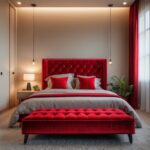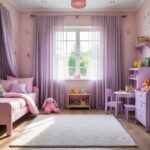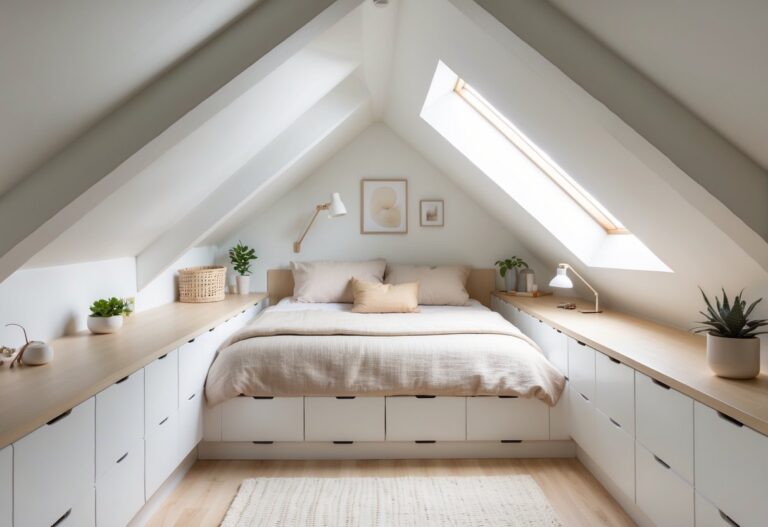
11 Attic Bedroom Ideas to Maximize Space and Style
Attic bedrooms offer a unique way to add living space without expanding a house’s footprint. They often have interesting shapes and angles that can create a cozy and private sleeping area. Many people see attics as unused space, but they have great potential for transformation.
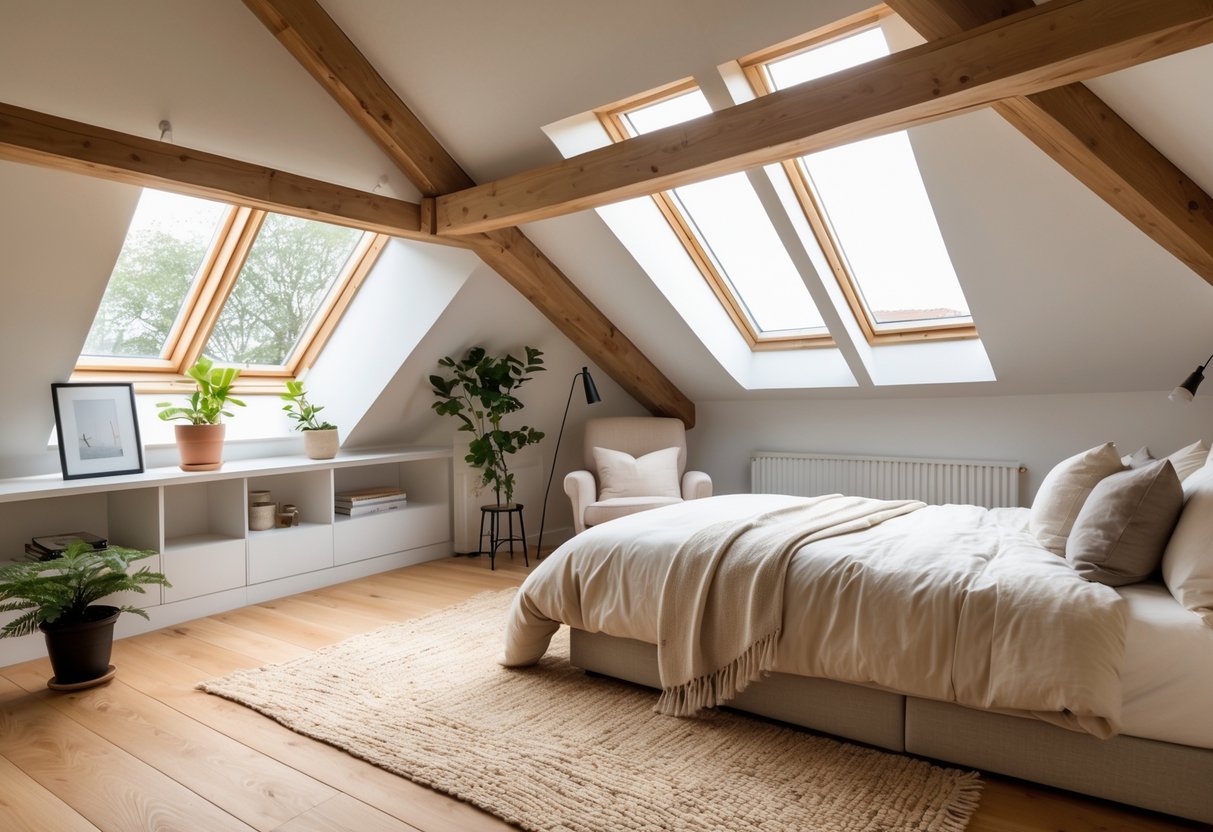
These 11 attic bedroom ideas show how to make the most of this space with smart design and practical solutions. Whether the ceiling is low or the space is limited, there are ways to create comfort and style in an attic bedroom.
1) Maximize natural light with skylights and large windows
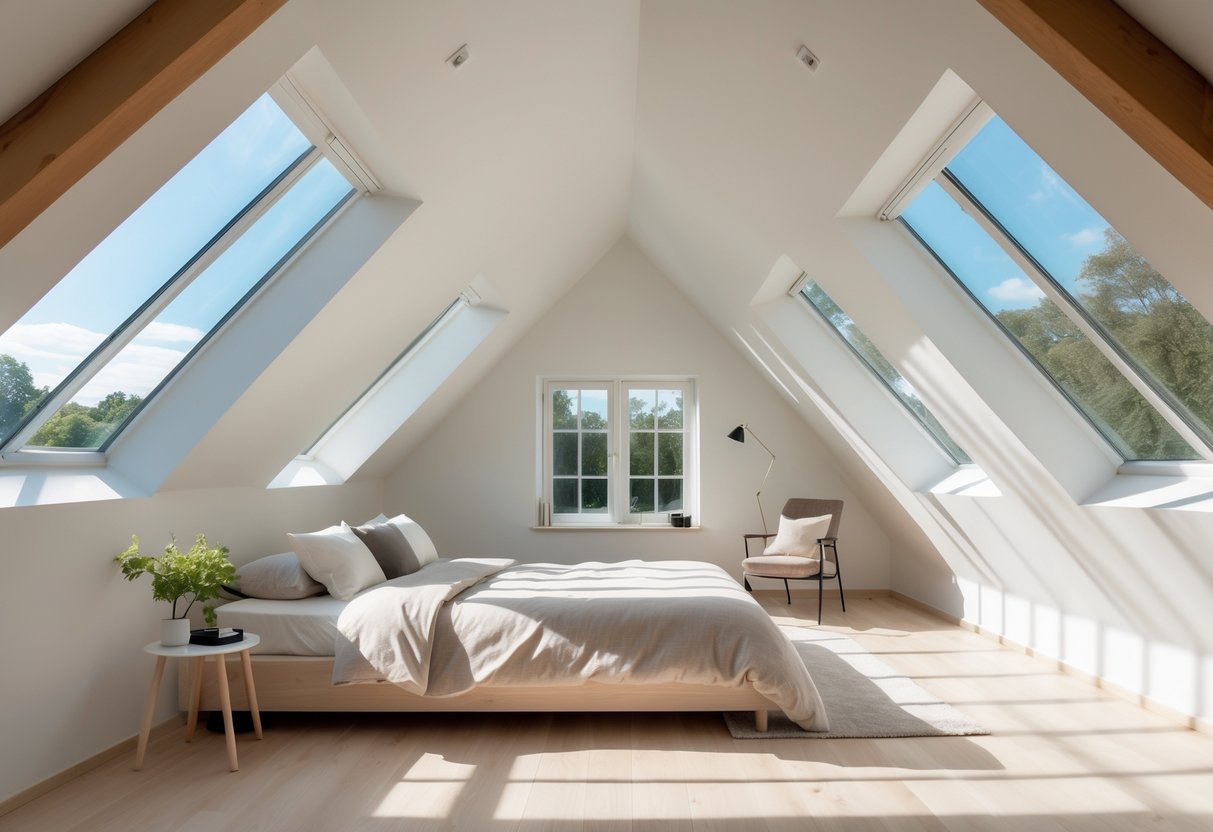
Skylights are a practical way to bring natural light into attic bedrooms. They help brighten the space by letting sunlight in from above, which is especially useful in rooms with sloped ceilings.
Large windows, including dormer windows, also increase light and improve air flow. Positioning the bed or seating near these windows can make the room feel more open and welcoming.
Using light-colored paint and mirrors can reflect the natural light further, making the attic look bigger. Combining skylights with windows allows for balanced daylight throughout the day.
This approach creates a bright and airy atmosphere without the need for strong artificial lighting. It also offers views of the sky, adding to the room’s appeal.
Overall, adding skylights and large windows is one of the best ways to improve natural light in attic bedrooms. It makes the space more comfortable and functional.
2) Use built-in storage solutions under sloped ceilings
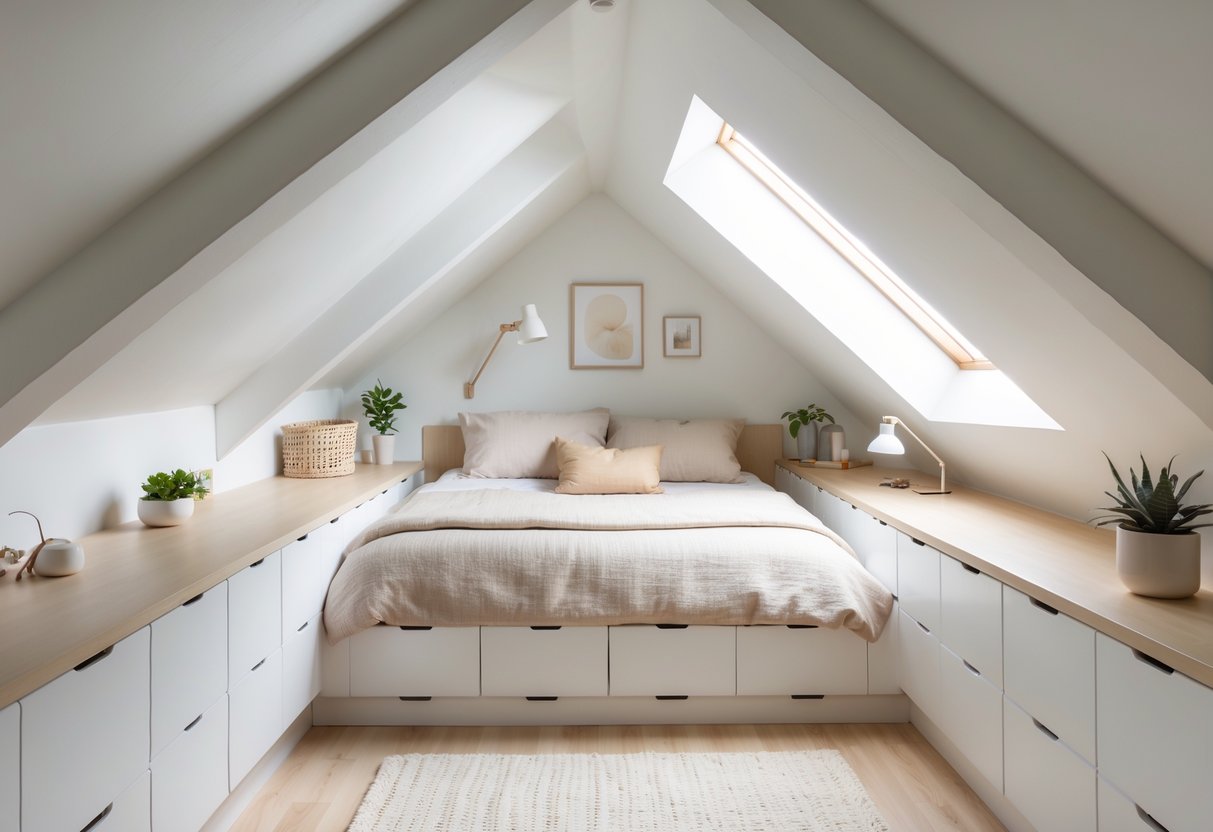
Built-in storage is a smart way to use the space under sloped ceilings. Custom cabinets or shelves can fit perfectly into the angled walls. This avoids wasted space and keeps the room organized.
Sliding doors on built-in wardrobes work well in tight areas. They save room by not swinging out. This helps keep the attic bedroom feeling open and neat.
Low shelves or drawers built into the eaves provide easy access to stored items. People can also use these spaces for shoes, books, or clothes. This creates more floor space and reduces clutter.
Under-bed storage complements built-in units nicely. It uses space that often goes unused. Combining these ideas can make even a small attic bedroom highly functional.
3) Create a cozy reading nook with cushions and low shelves
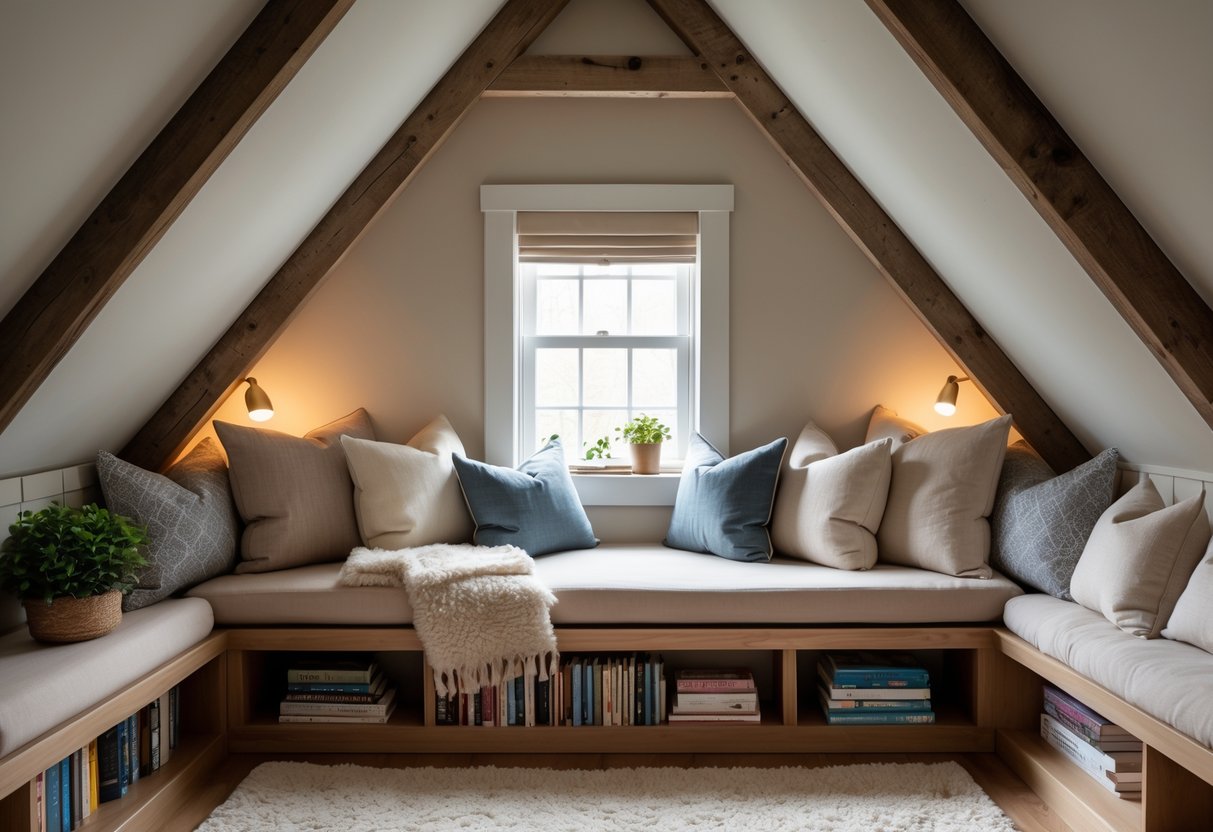
An attic bedroom is a great place to add a quiet reading nook. Using soft cushions on a low bench or directly on the floor makes the space comfortable and inviting. This setup fits well under sloped ceilings or near small windows.
Low shelves nearby hold books within easy reach. They keep the area organized without taking up too much space. Adding warm lighting, like a small lamp or fairy lights, helps create a relaxing atmosphere for reading.
Placing cushions in different textures adds comfort and style. It can also make the nook feel personal and cozy. This simple combination turns an unused corner of the attic into a peaceful retreat for reading or relaxing.
4) Incorporate warm wood paneling for a rustic feel
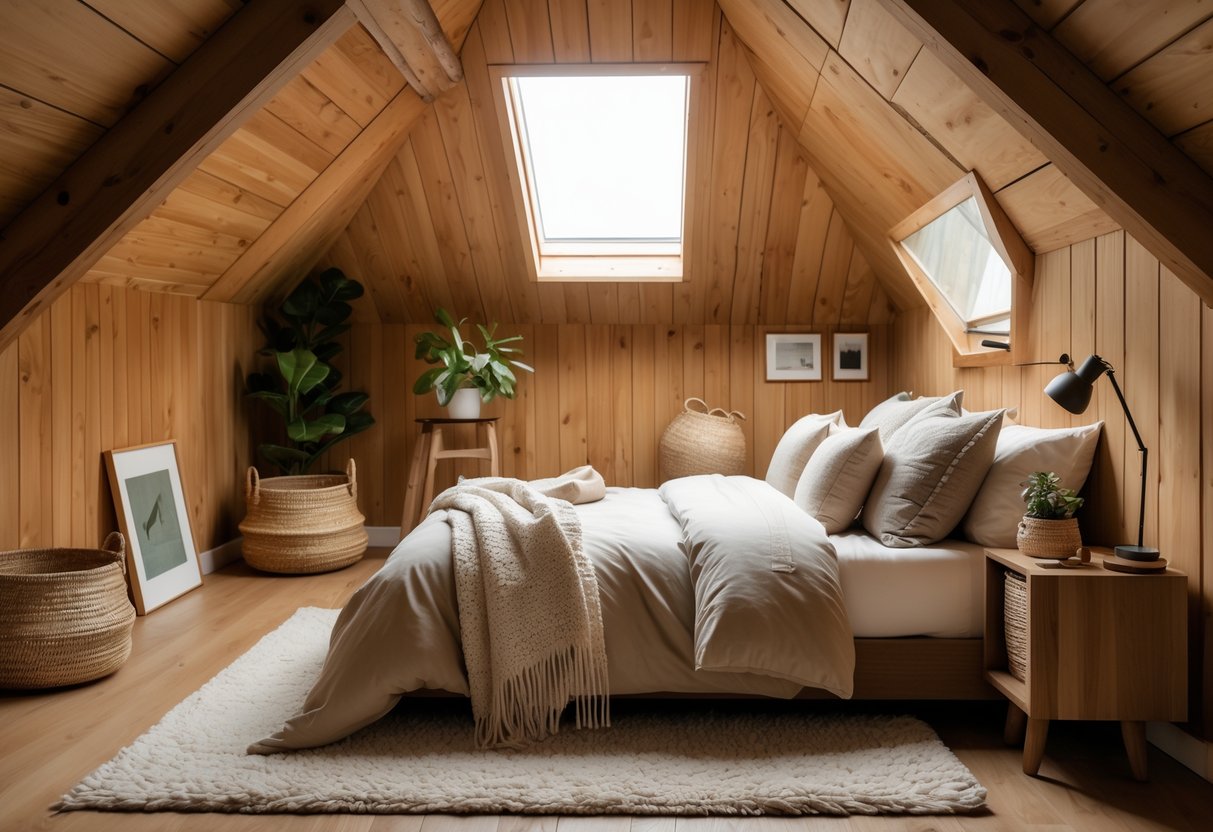
Wood paneling adds a natural, warm touch to any attic bedroom. It can cover walls or ceilings, creating a cozy and inviting space.
Choosing rich, warm tones of wood helps bring out a rustic charm. This look works well with exposed wooden beams or reclaimed wood accents.
Light washes or weathered finishes on the paneling can add texture without making the room feel dark. This balances warmth with openness in a small attic space.
Wood paneling pairs nicely with simple furniture and soft textiles. Earthy colors like browns, creams, and greens complement the wood’s natural beauty.
Using wooden elements encourages a connection to nature. It also creates a timeless backdrop that fits well with vintage or modern decor styles.
Layering in warm lighting, such as lantern-style lamps or string lights, enhances the wood’s cozy effect. This creates a relaxing atmosphere that suits an attic retreat.
5) Install recessed lighting for clean, unobtrusive illumination
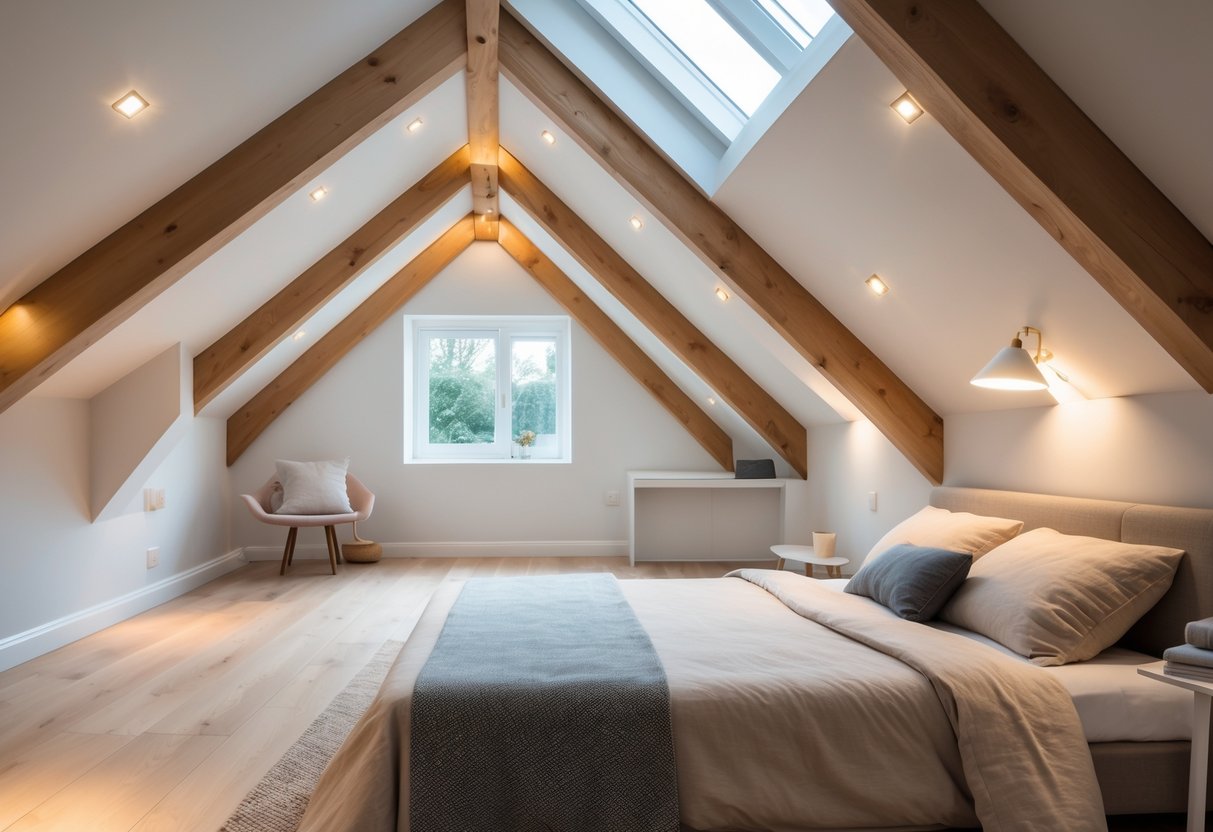
Recessed lighting is a smart choice for attic bedrooms. It fits flush with the ceiling, creating a simple and modern look. This helps keep the room feeling open and spacious.
These lights provide even, ambient illumination without bulky fixtures. They work well in smaller or sloped ceiling spaces where traditional lights might be awkward.
Installation can be done even without attic access. Newer LED models are easier to install and use less energy. Proper placement ensures the whole room is well-lit without shadows.
Recessed lighting is versatile. It suits various decorating styles and can highlight key areas, like reading corners or closets, without drawing attention to the fixture itself.
6) Choose a neutral color palette to enhance space and brightness
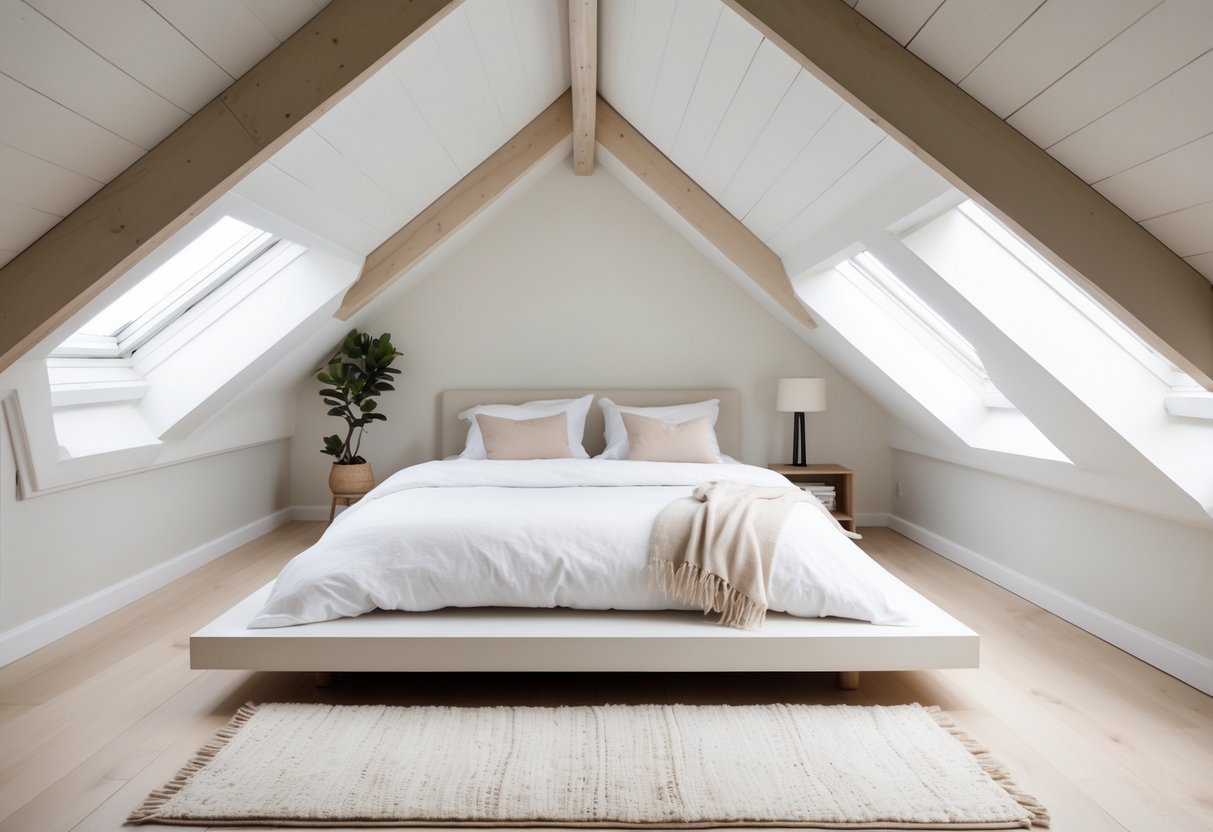
Using a neutral color palette helps make an attic bedroom feel larger and more open. Colors like soft whites, creams, gentle grays, and earthy tones reflect natural light well. This brightens the room and creates a calm atmosphere.
Neutral tones work well with the sloped ceilings often found in attics. They prevent the space from feeling cramped or dark. Light colors add airiness, which is important in smaller or low-ceiling rooms.
A neutral base also makes it easier to add touches of color through accessories. Pillows, rugs, or artwork can bring personality without overwhelming the room. This approach keeps the space balanced and inviting.
Choosing simple furniture in light colors supports the open feel. Heavy or dark pieces can make the attic seem smaller. Bringing in mirrors or sheer curtains can enhance light reflection and maintain brightness.
Overall, a neutral palette is a practical choice for attic bedrooms. It maximizes light and space while allowing flexibility in decorating styles.
7) Add a loft bed to optimize floor area
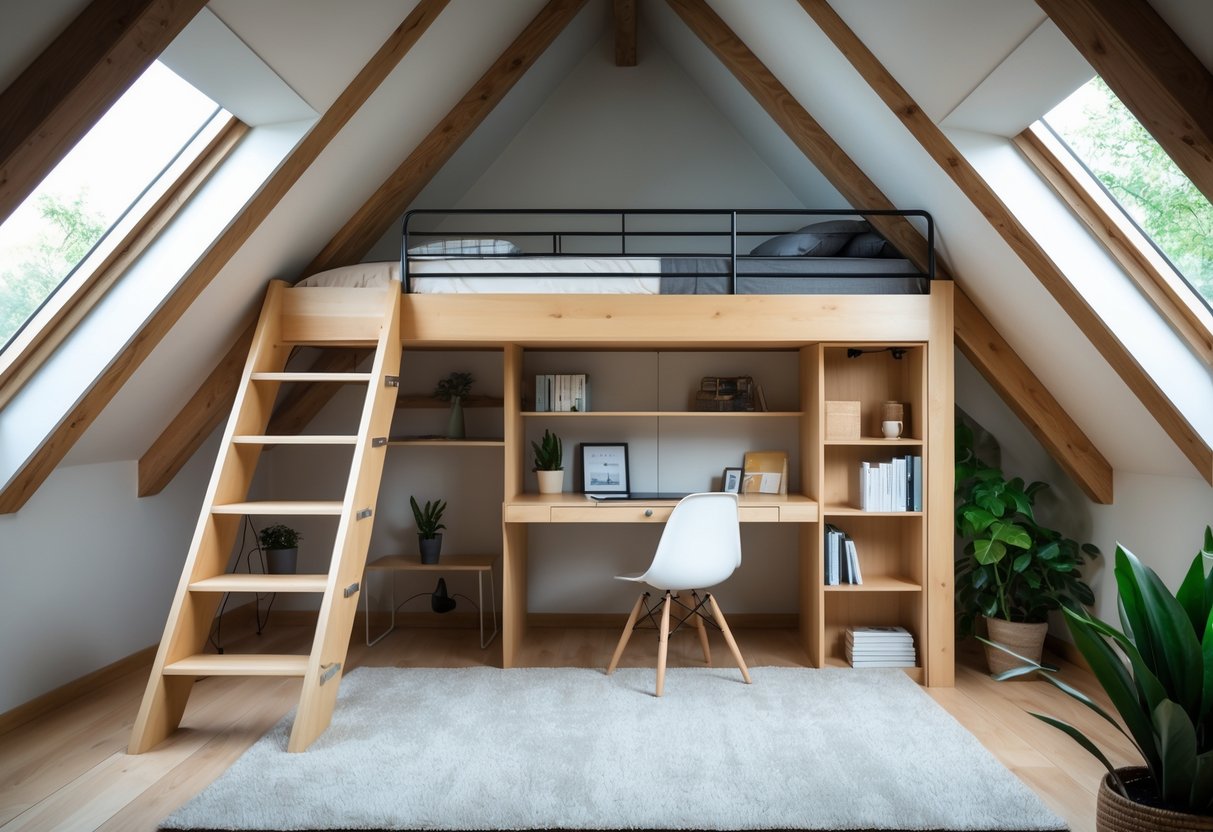
A loft bed is a smart way to save floor space in an attic bedroom. By raising the bed off the ground, it frees up the area below for other uses. This is especially helpful in rooms with limited square footage.
Underneath the loft bed, there is room for a desk, storage, or a seating area. This setup makes the most of vertical space, which is key in attics with sloped ceilings.
Loft beds come in many styles, from simple platforms to ones with built-in shelves or drawers. Choosing one with storage features can reduce the need for extra furniture, keeping the room open and tidy.
Placing a loft bed near a window can bring in natural light, enhancing the feeling of space. Proper lighting beneath the bed also helps make the lower area functional.
Overall, a loft bed creates a flexible bedroom layout. It allows for multiple uses in a small attic while maintaining comfort and style.
8) Use mirrors strategically to reflect light and open the room
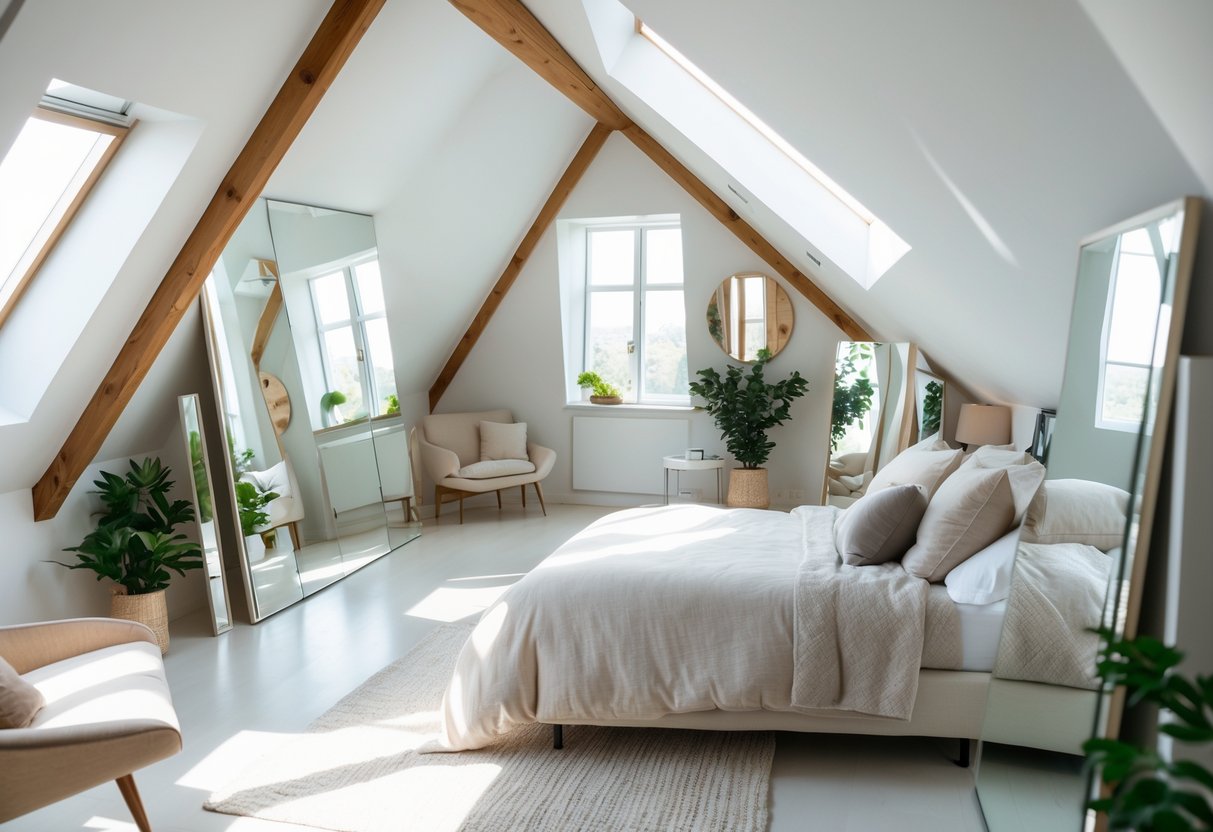
Mirrors help make attic bedrooms feel larger by reflecting natural and artificial light. Placing mirrors opposite windows bounces sunlight around the space, brightening dark corners.
They can also create the illusion of depth. A well-positioned mirror reflects parts of the room, making it seem more open and less cramped.
Choosing mirrors with simple frames or grid patterns can add style without overwhelming the small space. Avoid heavy or dark frames that might make the room feel more closed in.
Mirrors can reflect attractive views or decor elements, which adds visual interest and connects the room to the outdoors. This enhances the feeling of openness in a small attic bedroom.
Using mirrors near seating or storage areas can also improve function, giving the room a polished and balanced look. The right mirror placement supports both light and layout in the attic space.
9) Incorporate underfloor heating for comfort
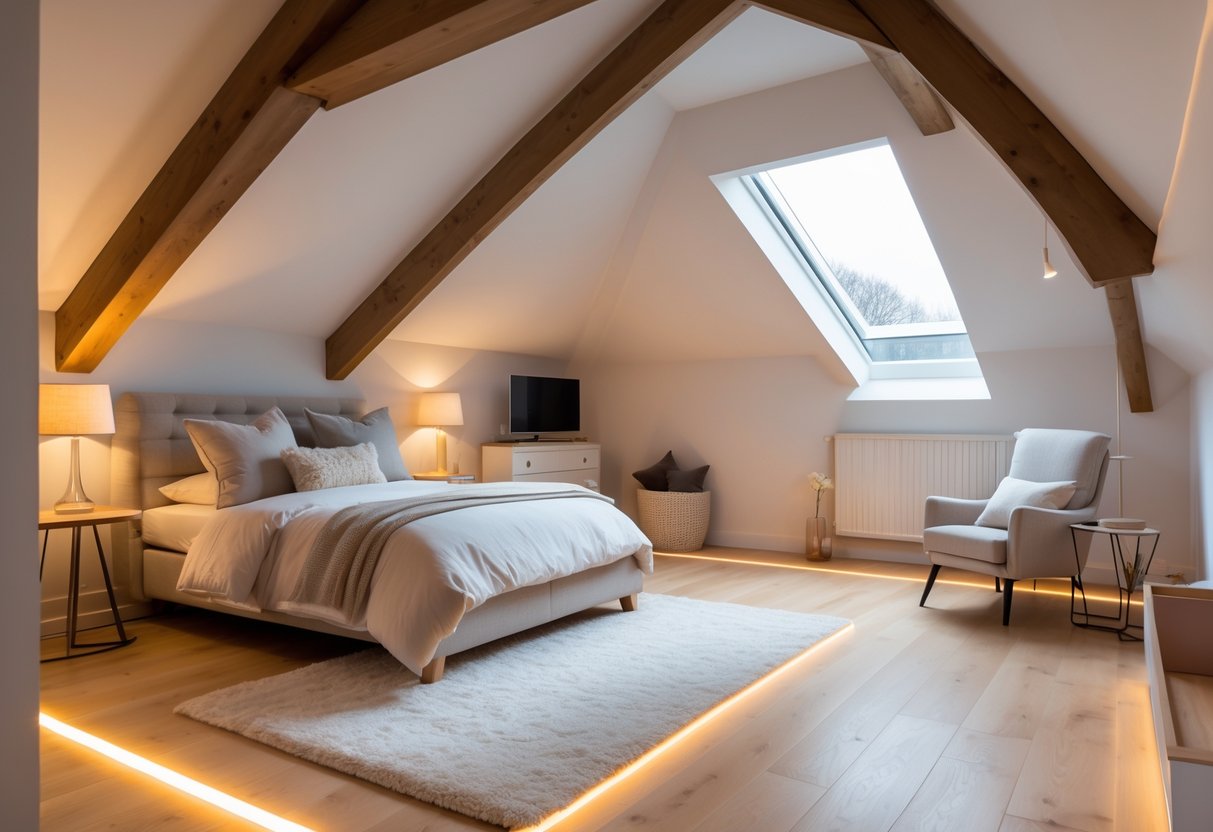
Adding underfloor heating is a smart way to keep an attic bedroom warm. Because heat rises, it helps the whole room stay cozy, even with sloped ceilings.
Underfloor heating works well with good insulation. It spreads warmth evenly across the floor, making the space comfortable without using bulky heaters or radiators.
This heating method is especially useful in attics, which often feel colder than lower floors. It helps avoid cold spots and creates a welcoming atmosphere during colder months.
Installing underfloor heating can also save space. Since it is hidden under the floor, it allows for more flexible furniture placement and keeps the room looking neat.
For best results, combine underfloor heating with proper insulation. Together, they improve energy efficiency and help maintain a consistent temperature throughout the attic bedroom.
10) Design a custom wardrobe that fits angled walls
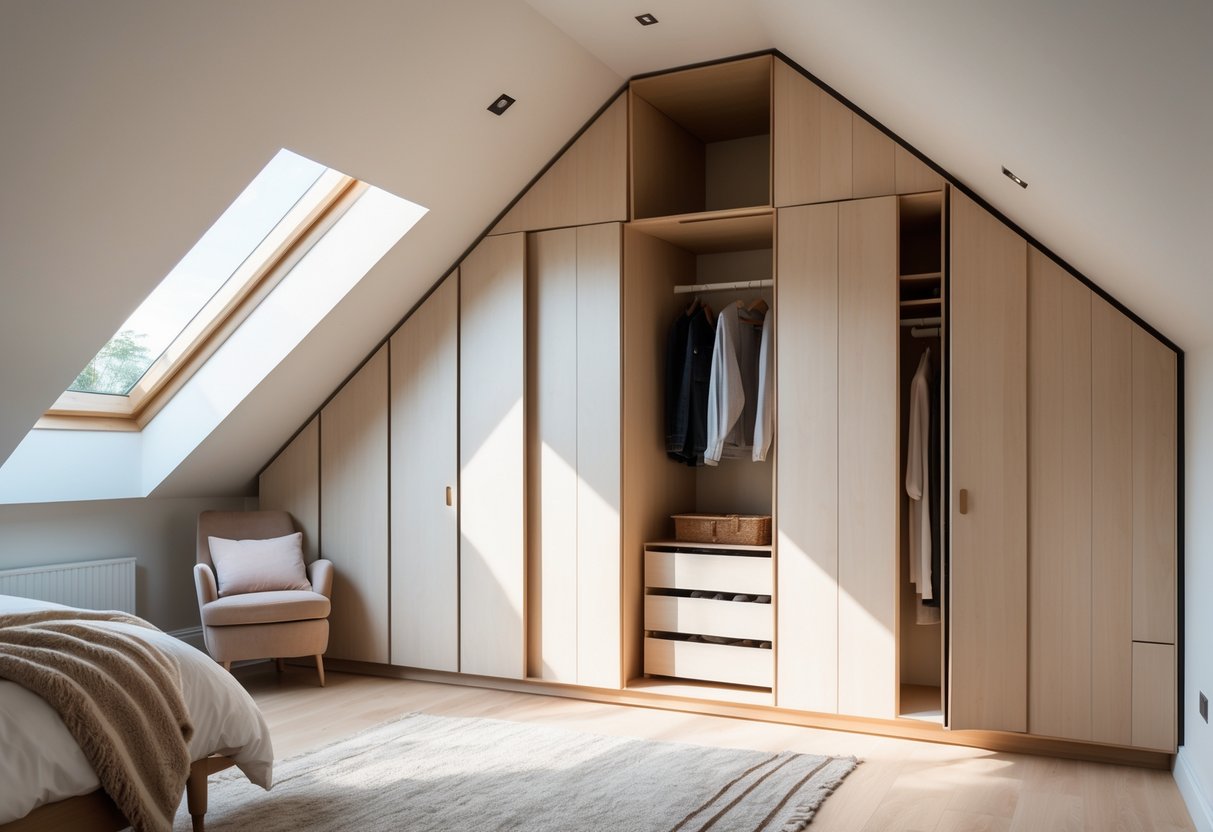
A custom wardrobe is a great way to use the unique space under angled walls in an attic bedroom. Standard wardrobes often don’t fit well because of sloped ceilings or irregular shapes. Custom designs allow the wardrobe to match these angles perfectly.
These wardrobes can be built to take full advantage of limited vertical space. They can include shelves, drawers, and hanging areas adjusted to the ceiling’s slope. This makes storage more efficient and organized.
Custom wardrobes also help keep the room looking neat. They fit directly against the wall, avoiding gaps or awkward spaces. This leads to a cleaner, more cohesive look in the attic bedroom.
By designing the wardrobe to fit unusual shapes, it is easier to keep clutter out of sight. This improves the feel of the room and makes it more comfortable to use. Many companies offer tailored wardrobes that suit angled ceilings and walls.
11) Use light, airy curtains to maintain openness
Using light, airy curtains helps keep an attic bedroom feeling open and bright. Heavy or dark curtains can block sunlight and make the space feel smaller and more closed-in.
Sheer or white curtains allow natural light to pass through while still offering privacy. This helps brighten the room without the need for strong artificial lighting.
Light curtains also add a soft, fresh look that works well with the often sloped ceilings in attics. They create a gentle flow, making the room feel less crowded.
Choosing simple, breathable fabric supports good airflow. This keeps the room comfortable, especially in smaller attic spaces where ventilation can be limited.
Overall, light curtains are a simple way to improve the openness and brightness of an attic bedroom. They work well with light paint colors and minimal furniture to enhance the space’s airy feel.
Common Challenges and Smart Solutions
Attic bedrooms often have unique design obstacles that need thoughtful handling to create a comfortable and functional space. Issues with ceiling shapes, light availability, and temperature control are common but can be managed with clear strategies.
Addressing Sloped Ceilings
Sloped ceilings can limit the usable space in an attic bedroom. Installing low furniture like beds and storage under the lowest parts makes the most of these awkward areas. Custom built-ins are also effective because they fit the angles precisely and reduce wasted space.
Using vertical elements near taller walls draws the eye upward and balances the room’s shape. Avoid tall wardrobes or shelves that block movement or make the room feel cramped. Instead, focus on versatile pieces that serve multiple functions.
Maximizing Natural Light
Natural light is often scarce in attic bedrooms due to small or limited windows. Adding skylights or dormer windows drastically increases light and makes the space feel larger. Positioning mirrors opposite windows reflects sunlight, brightening dark corners.
Light-colored walls and furniture help reflect light throughout the room. Using sheer window treatments allows maximum daylight while maintaining privacy. Task lighting in darker areas supports functionality without overcrowding the room with fixtures.
Insulation and Temperature Control
Attics typically face temperature extremes, becoming hot in summer and cold in winter. Proper insulation in the roof and walls is essential to maintain a comfortable climate year-round. Using materials like spray foam or rigid foam boards can seal gaps and improve energy efficiency.
Installing ceiling fans or portable heaters can further regulate temperature without high energy costs. Window treatments that block heat in summer and retain warmth in winter help balance indoor climate. Ventilation should support air circulation to prevent dampness and mold growth.
Design Considerations for Attic Bedrooms
Attic bedrooms require thoughtful design to work well with their unique shape and size. Choosing the right colors and furniture can make the space feel larger and more comfortable.
Selecting Color Schemes
Light colors help brighten attic bedrooms by reflecting natural light from small windows or skylights. Whites, soft grays, and pale blues can make sloped ceilings seem less heavy and reduce the feeling of cramped space.
Using darker colors is possible but should be balanced with lighter accents to avoid a gloomy look. Accent walls or decorative elements in muted tones can add interest without overwhelming the room.
Matte or eggshell paint finishes work best for walls, as they reduce glare and soften the light, creating a calm atmosphere.
Space-Efficient Furniture Choices
Furniture in attic bedrooms must fit awkward angles and limited floor space. Low-profile beds or platform beds without tall headboards help keep sightlines open.
Multipurpose furniture pieces, like beds with storage drawers underneath or foldable desks, maximize usability. Built-in shelves and cabinets built into eaves use otherwise wasted space effectively.
Choosing lightweight or modular furniture allows easy rearrangement, helping adapt the room as needs change. Avoid bulky pieces that block pathways or make the room feel cluttered.
Frequently Asked Questions
Attic bedrooms require careful planning to make the most of limited space and sloped ceilings. Using light, storage, and thoughtful layouts can improve comfort and functionality. Design choices also depend on style preferences and practical needs like adding a bathroom or meeting building codes.
How can you design a cozy attic bedroom within a small space?
They should maximize natural light using skylights or large windows to make the room feel bigger. Built-in storage under sloped ceilings helps keep the room organized without taking up extra space. Adding a small reading nook with cushions and low shelves creates a comfortable and inviting corner.
What are the best design ideas for adult-themed attic bedrooms?
Adults might prefer warm wood paneling to add a rustic and calming atmosphere. Recessed lighting provides subtle brightness without cluttering the ceiling. Choosing neutral colors and minimalist furniture keeps the space tidy and modern.
What creative DIY projects can enhance an attic bedroom?
Installing floating shelves along lower walls can add storage and display space. Creating custom-built storage boxes or drawers to fit sloped areas maximizes utility. Painting or adding removable wallpaper can personalize the space without permanent changes.
What are the modern design trends for attic bedrooms in 2025?
Natural light remains a priority, with larger skylights becoming common. Sustainable materials like reclaimed wood are popular for warmth and style. Clean lines with recessed or track lighting create a sleek, uncluttered look.
How to plan an effective layout for an attic bedroom and bathroom combo?
Placing the bathroom near existing plumbing lines reduces renovation costs. It’s important to leave enough room for comfortable movement between bedroom and bathroom areas. Using sliding doors helps save space and maintain a smooth flow.
What minimum ceiling height is required to convert an attic into a livable bedroom?
Building codes typically require a minimum ceiling height of 7 feet in at least half of the usable floor area. Areas under sloped ceilings can be lower if they are not the main walking zone. It is important to check local regulations before beginning conversion.
